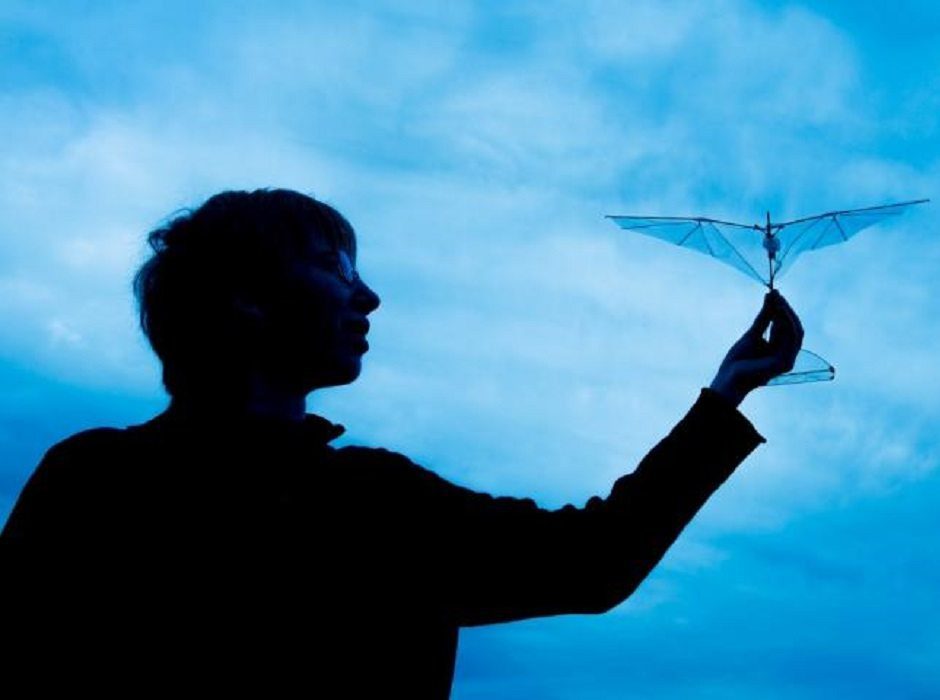[dropcap style=”font-size:100px; color:#992211;”]N[/dropcap]ew drone wings that allow the airborne nuisances to absorb impact. Great.
Can we get the same technology on commercial aircraft too, please?
Researchers in the US have taken inspiration from nature to create a robotic wing that can recover from mid-air collisions.
By examining the wings of birds and bats, the researchers, from Stanford University, have created a mechanism that could allow future flying robots to easily squeeze between obstacles, such as branches of a tree, and fully recover after accidental hard impacts.
The results have been published today, 26 March, as part of a special issue in IOP Publishing’s journal Bioinspiration and Biomimetics.
Whilst animals have mastered the art of manoeuvring through complex environments, researchers have yet to design mechanisms that make it easy for man-made robots.
When it comes to flying, birds such as pigeons and swallows can morph their wings until they are tucked close into their body, allowing them to pass through gaps.
In their study, the researchers created one of the first mechanisms in which the morphing of the wing was completely passive, requiring no actuation to fold or unfold, making the wing much lighter and more reliable.
The robotic wing was modelled on bat and bird wings and was made using carbon fibre and Mylar film. Similar to a bird wing, each of the two robotic wings had a wrist joint, which were custom built using a 3D printer.
[Photo: Graduate student Amanda Stowers of The Lentink Lab at Stanford University demonstrates her passive morning wing design for a flapping robot. The wrist hinge enables the robot to comply with hard impact of a steel rod, while the flapping motion forces the wings to fully extend again after impact.]
The Lentink Lab at Stanford University demonstrates her passive morning wing design for a flapping robot. The wrist hinge enables the robot to comply with hard impact of a steel rod, while the flapping motion forces the wings to fully extend again after impact.]
The pin joint connected the arm wing and the hand wing. The arm wing attached to the body of the robot at the shoulder joint, which initiated the flapping. The complete wing set had a wingspan of 400 mm and a length (chord) of 80 mm.
The wrist joint of the wing was hinged so, as the rest of the wing flapped, the hand could freely fold and unfold over the arm, much like origami folding, without any actuation.
The researchers performed theoretical, numerical and physical simulations on the robotic wing and successfully demonstrated that when the wing flapped, the folded hand wing was able to unfold back to the full wingspan configuration passively.
Co-author of the study Dr David Lentink said: ‘Both the math and simulations worked out, showing that both tiny and big flapping wings can all morph passively within a wing beat. We were surprised it worked so well.’
The hinged wrist joint also allowed the robotic wing to temporarily morph its hand when it came into hard contact with a rigid object; in this study the researchers used a 7mm steel rod. The joint allowed the robotic wing to comply with the object at impact and, after impact, the flapping motion caused the wing to automatically re-extend.
This is similar to how the flexible feathers of a bird allow for impact with obstacles without affecting the structural integrity of the wing.
Lead author of the study Amanda Stowers said: ‘While birds are capable of responding to unexpected disturbances to their wings, these same disturbances would break the wings of most drones. By adding a passive wrist joint, the flapping wing we have produced can withstand an impact and recover automatically back to its original position.
‘Furthermore, the flapping wing can resist impact with minimal added weight and without any computer intelligence or power.’
Dr Lentink continued: ‘After her discovery of passive wing morphing in the lab, I advised Amanda to hit her robot wing hard with a stick to see how well it could handle hard impact. We were both impressed that she could basically use a rod like a baseball bat and hit the hand wing of the robot, and it would still recover just fine.
‘This finding will greatly help make flapping winged drones much more robust. This is essential if we ever want to safely fly through a forest or land in a tree like a bird. The Office of Naval Research wanted us to find solutions to enable drones to fly in such cluttered environments, and this is a promising step forward.’
Image: Linda Cicero, Stanford University
This paper can be downloaded from http://iopscience.

Some of the news that we find inspiring, diverting, wrong or so very right.



















